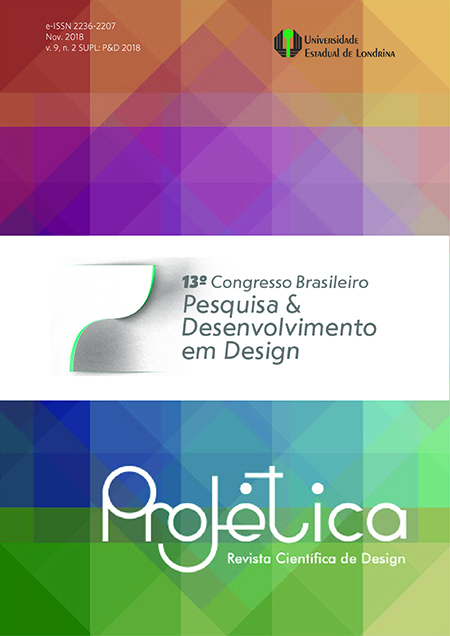Como assim não estava no briefing? Novas perspectivas sobre o briefing no processo de design a partir da Teoria Ator-Rede
DOI:
https://doi.org/10.5433/2236-2207.2018v9n2Suplp89Palabras clave:
Briefing, Processo de design, Teoria Ator-RedeResumen
Quando se trata do briefing, há um descompasso entre o que os estudos em design apontam a seu respeito e o que se postula sobre o processo de design. Enquanto briefing é entendido como algo que explicita e documenta os problemas, orientando o processo projetual, os estudos sobre processo de design apontam para um contexto difuso e não-linear, orientado por dinâmicas adaptativas frente aos contextos que o design se propõe enfrentar – sejam estes a geração de produtos e serviços ou estratégias organizacionais orientadas à inovação. Partindo da análise documental de 58 briefings, esta pesquisa procura compreender quem é o briefing em uso, como se materializa e quais processualidades lhe competem no processo de design. Para isto, princípios e conceitos da Teoria Ator-Rede permitem evidenciar a plasticidade de suas materializações e actancialidades evocativas que mediam o processo de projeto, em um caráter transformativo além do normativo, situado na esfera das possibilidades.Descargas
Citas
BINDER, Thomas et al. Democratic design experiments: between parliament and laboratory. CoDesign, London, v. 11, n. 3-4, p. 152-165, 2015.
BJÖRGVINSSON, Erling; EHN, Pelle; HILLGREN, Per-Anders. Participatory design and “democratizing innovation”. In: PARTICIPATORY DESIGN CONFERENCE, 11., 2010, Sydney. Anais… Ney York: ACM, 2010. p. 41-50.
BROWN, Tim. Change by design: how design thinking transforms organization and inspires innovation. New York: HarperCollins, 2009.
BUCHANAN, Richard. Wicked problems in design thinking. Design issues, Illinois, v. 8, n. 2, p. 5-21, 1992.
BUCHANAN, Richard. Worlds in the making: design, management, and the reform of organizational culture. She Ji: The Journal of Design, Economics, and Innovation, Shangai, v. 1, n. 1, p. 5-21, 2015.
CALLON, Michel. Some elements of a sociology of translation: domestication of the scallops and the fishermen. The Sociological Review, Oxford, v. 32, p. 196-233, May 1984.
FINDELI, Alain. Rethinking design education for the 21st century: theoretical, methodological, and ethical discussion. Design Issues, Cambridge, v. 17, n. 1, p. 5-17, 2001.
KRIPPENDORFF, Klaus. Content analysis: an introduction to its methodology. Thousand Oaks: Sage, 2012.
LATOUR, Bruno. On actor-network theory: a few clarifications. Soziale Welt, Baden-Baden, v. 47, p. 369-381, 1996.
LATOUR, Bruno. On recalling ANT. The Sociological Review, Oxford, v. 47, n. 1, p. 15-25, 1999.
LATOUR, Bruno. Reassembling the social: an introduction to actor-networktheory. Oxford: Oxford University Press, 2005.
LATOUR, Bruno. Science in action: how to follow scientists and engineers through society. Cambridge: Harvard University Press, 1987.
LATOUR, Bruno. What is the style of matters of concern: two lectures in empirical philosophy. Amsterdam: Van Gorcum, 2008.
LAW, John. After ANT: complexity, naming and topology. The Sociological Review, Oxford, v. 47, n. 1, p. 1-14, 1999.
LAW, John. Notes on the theory of the actor-network: ordering, strategy, and heterogeneity. Systems Practice, New York, v. 5, n. 4, p. 379-393, 1992.
BRIEFING. In: Merriam-Webster. Disponível em: https://www.merriam-webster.com/dictionary/briefing. Acesso em: 24 jul. 2016a.
BRIEFING. In: Oxford dictionaries. Disponível em: https:// en.oxforddictionaries.com/definition/briefing. Acesso em: 24 jul. 2016b.
RITTEL, Horst Willhelm Jakob; WEBBER, Melvin Myron. Dilemmas in a general theory of planning. Policy Sciences, Amsterdam, v. 4, n. 2, p. 155-169, 1973.
SÁ-SILVA, Jackson Ronie; ALMEIDA, Cristóvão Domingos de; GUINDANI, Joel Felipe. Pesquisa documental: pistas teóricas e metodológicas. Revista Brasileira de História & Ciências Sociais, Santa Vitória do Palmar, v. 1, n. 1, p. 1-15, 2009. Disponível em: https://www.rbhcs.com/rbhcs/article/view/6/. Acesso em: 30 jul. 2016.
SAYES, Edwin. Actor-network theory and methodology: just what does it mean to say that nonhumans have agency? Social Studies of Science, London, v. 44, n. 1, p. 134-149, 2014.
STORNI, Cristiano et al. Designing things together: intersections of co-design and actor-network theory. CoDesign, London, v. 11, n. 3-4, p. 149-151, 2015.
ZURLO, Francesco. Design strategico. Treccani. 2010. Disponível em: http://www.treccani.it/enciclopedia/design-strategico_%28XXI-Secolo%29/. Acesso em: 30 abr. 2014.
Descargas
Publicado
Cómo citar
Número
Sección
Licencia
Projética está licenciada sob a Creative Commons Attribution CC-BY 4.0 International. Os autores detém os direitos autorais e concedem à revista o direito de exclusividade de primeira publicação.
Os autores dos trabalhos aprovados autorizam Projética a, após a publicação, ceder seu conteúdo para reprodução em indexadores de conteúdo, bibliotecas virtuais e similares.
Os autores assumem que os textos submetidos à publicação são de sua criação original, responsabilizando-se inteiramente por seu conteúdo em caso de eventual impugnação por parte de terceiros. As opiniões emitidas pelos autores dos artigos são de sua exclusiva responsabilidade.
A revista se reserva o direito de efetuar, nos originais, alterações de ordem normativa, ortográfica e gramatical, com vistas a manter o padrão culto da língua e a credibilidade do veículo. Respeitará, no entanto, o estilo de escrever dos autores. Alterações, correções ou sugestões de ordem conceitual serão encaminhadas aos autores, quando necessário. Nesses casos, os artigos, depois de adequados, deverão ser submetidos a nova apreciação. As provas finais não serão encaminhadas aos autores.











